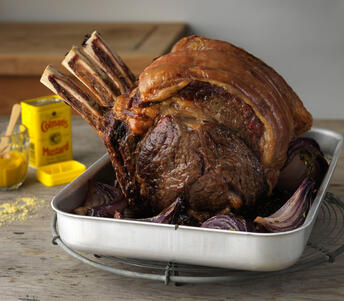
Ingredients
- Native Pork, Beef, or Lamb Celebration Joint
- 1 x Large Onion
- 1 x Carrot
- 1 x Celeriac
- 1 x Split Garlic Bulb (if using lamb)
Introduction
This recipe provides tips to get the most out of your celebration joint, whether pork, beef, or lamb.Method
- For roasting your celebration joint, I would suggest buying a meat thermometer; a really useful tool to get your favourite joints just how you like them to be. Always be sure to jot down the weight of your joint before starting, then take out of the chiller and allow to get to room temperature.
- Roasting on a trivet is an excellent way to roast a joint, resting on vegetables, (a large cut onion, carrot, and celeriac is my preferred choice, and adding a split bulb of garlic if I'm roasting lamb).
- The trivet ensures aromatic cooking, preventing the base from drying out, while also providing the base for your gravy. Before roasting pat dry any excess moisture to ensure the joint can roast more evenly, and which will help with the caramalisation (Maillard reaction).
- Always pre-heat your oven!
- When preparing the oven I start nice and hot at around 225°C. For pork I score the skin all over - a good tip is to use a Stanley blade - then scald the rind with hot water. Before roasting rub your joint (whether pork, lamb, or beef) with sea salt and a little goose or duck fat, if there’s not a healthy coating of natural fat there already.
- Place on the trivet and roast for 20 minutes.
- Next reduce the heat to 175°C. For beef and lamb keep roasting for 20 minutes per 500g, and pork 30 minutes per 500g. When using the thermometer I suggest the perfect core temperatures are 54°C for medium rare beef, 58°C for pink lamb, and 65°C for pork once the joints are cooked.
- Be sure to leave the joint to rest before carving for up to half the cooking time to let the proteins relax.







